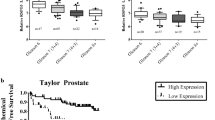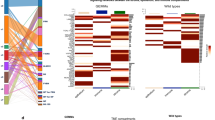Abstract
Development of metastasis is a leading cause of cancer-induced death. Acquisition of an invasive tumor cell phenotype suggests loss of cell adhesion and basement membrane breakdown during a process termed epithelial-to-mesenchymal transition (EMT). Recently, cancer stem cells (CSC) were discovered to mediate solid tumor initiation and progression. Prostate CSCs are a subpopulation of CD44+ cells within the tumor that give rise to differentiated tumor cells and also self-renew. Using both primary and established prostate cancer cell lines, we tested the assumption that CSCs are more invasive. The ability of unsorted cells and CD44-positve and -negative subpopulations to undergo Matrigel invasion and EMT was evaluated, and the gene expression profiles of these cells were analyzed by microarray and a subset confirmed using QRT-PCR. Our data reveal that a subpopulation of CD44+ CSC-like cells invade Matrigel through an EMT, while in contrast, CD44− cells are non-invasive. Furthermore, the genomic profile of the invasive cells closely resembles that of CD44+CD24− prostate CSCs and shows evidence for increased Hedgehog signaling. Finally, invasive cells from DU145 and primary prostate cancer cells are more tumorigenic in NOD/SCID mice compared with non-invasive cells. Our data strongly suggest that basement membrane invasion, an early and necessary step in metastasis development, is mediated by these potential cancer stem cells.







Similar content being viewed by others
References
Fidler IJ (2003) The pathogenesis of cancer metastasis: the ‘seed and soil’ hypothesis revisited. Nat Rev Cancer 3(6):453–458. doi:10.1038/nrc1098
Molloy T, van‘t Veer LJ (2008) Recent advances in metastasis research. Curr Opin Genet Dev 18:1–7
Steeg PS (2006) Tumor metastasis: mechanistic insights and clinical challenges. Nat Med 12(8):895–904. doi:10.1038/nm1469
Hugo H, Ackland ML, Blick T et al (2007) Epithelial–mesenchymal and mesenchymal–epithelial transitions in carcinoma progression. J Cell Physiol 213(2):374–383. doi:10.1002/jcp.21223
Thiery JP (2002) Epithelial–mesenchymal transitions in tumour progression. Nat Rev Cancer 2(6):442–454. doi:10.1038/nrc822
Huber MA, Kraut N, Beug H (2005) Molecular requirements for epithelial–mesenchymal transition during tumor progression. Curr Opin Cell Biol 17(5):548–558. doi:10.1016/j.ceb.2005.08.001
Fidler IJ, Gruys E, Cifone MA et al (1981) Demonstration of multiple phenotypic diversity in a murine melanoma of recent origin. J Natl Cancer Inst 67(4):947–956
Lobo NA, Shimono Y, Qian D et al (2007) The biology of cancer stem cells. Annu Rev Cell Dev Biol 23:675–699
Miki J, Rhim JS (2008) Prostate cell cultures as in vitro models for the study of normal stem cells and cancer stem cells. Prostate Cancer Prostatic Dis 11(1):32–39. doi:10.1038/sj.pcan.4501018
Patrawala L, Calhoun T, Schneider-Broussard R et al (2006) Highly purified CD44+ prostate cancer cells from xenograft human tumors are enriched in tumorigenic and metastatic progenitor cells. Oncogene 25(12):1696–1708. doi:10.1038/sj.onc.1209327
Hurt EM, Kawasaki BT, Klarmann GJ et al (2008) CD44+CD24(−) prostate cells are early cancer progenitor/stem cells that provide a model for patients with poor prognosis. Br J Cancer 98(4):756–765. doi:10.1038/sj.bjc.6604242
Collins AT, Berry PA, Hyde C et al (2005) Prospective identification of tumorigenic prostate cancer stem cells. Cancer Res 65(23):10946–10951. doi:10.1158/0008-5472.CAN-05-2018
Yu SC, Bian, XW (2008) Enrichment of cancer stem cells based on heterogeneity of invasiveness. Stem Cell Rev
Hendrix MJ, Seftor EA, Seftor RE et al (1987) A simple quantitative assay for studying the invasive potential of high and low human metastatic variants. Cancer Lett 38(1–2):137–147. doi:10.1016/0304-3835(87)90209-6
Hendrix MJ, Seftor EA, Seftor RE et al (1989) Comparison of tumor cell invasion assays: human amnion versus reconstituted basement membrane barriers. Invasion Metastasis 9(5):278–297
Hurt EM, Klarmann GJ, Kawasaki BT et al (2008) Prostate cancer stem cells. In: Majumder S (ed) Stem cells and cancer. Springer, New York
Mootha VK, Lindgren CM, Eriksson KF et al (2003) PGC-1alpha-responsive genes involved in oxidative phosphorylation are coordinately downregulated in human diabetes. Nat Genet 34(3):267–273. doi:10.1038/ng1180
Subramanian A, Tamayo P, Mootha VK et al (2005) Gene set enrichment analysis: a knowledge-based approach for interpreting genome-wide expression profiles. Proc Natl Acad Sci USA 102(43):15545–15550. doi:10.1073/pnas.0506580102
Blalock EM, Geddes JW, Chen KC et al (2004) Incipient Alzheimer’s disease: microarray correlation analyses reveal major transcriptional and tumor suppressor responses. Proc Natl Acad Sci USA 101(7):2173–2178. doi:10.1073/pnas.0308512100
Funato N, Ohyama K, Kuroda T et al (2003) Basic helix-loop-helix transcription factor epicardin/capsulin/Pod-1 suppresses differentiation by negative regulation of transcription. J Biol Chem 278(9):7486–7493. doi:10.1074/jbc.M212248200
Du L, Wang H, He L et al (2008) CD44 is of functional importance for colorectal cancer stem cells. Clin Cancer Res 14(21):6751–6760. doi:10.1158/1078-0432.CCR-08-1034
Klarmann GJ, Decker A, Farrar WL (2008) Epigenetic gene silencing in the Wnt pathway in breast cancer. Epigenetics 3(2):59–63
Liu S, Dontu G, Mantle ID et al (2006) Hedgehog signaling and Bmi-1 regulate self-renewal of normal and malignant human mammary stem cells. Cancer Res 66(12):6063–6071. doi:10.1158/0008-5472.CAN-06-0054
Pan G, Thomson JA (2007) Nanog and transcriptional networks in embryonic stem cell pluripotency. Cell Res 17(1):42–49. doi:10.1038/sj.cr.7310125
Morel AP, Lievre M, Thomas C et al (2008) Generation of breast cancer stem cells through epithelial–mesenchymal transition. PLoS ONE 3(8):e2888. doi:10.1371/journal.pone.0002888
Mani SA, Guo W, Liao MJ et al (2008) The epithelial–mesenchymal transition generates cells with properties of stem cells. Cell 133(4):704–715. doi:10.1016/j.cell.2008.03.027
Croker AK, Goodale D, Chu J et al. (2008) High aldehyde dehydrogenase and expression of cancer stem cell markers selects for breast cancer cells with enhanced malignant and metastatic ability. J Cell Mol Med
Loric S, Paradis V, Gala JL et al (2001) Abnormal E-cadherin expression and prostate cell blood dissemination as markers of biological recurrence in cancer. Eur J Cancer 37(12):1475–1481. doi:10.1016/S0959-8049(01)00143-5
Cano A, Perez-Moreno MA, Rodrigo I et al (2000) The transcription factor snail controls epithelial–mesenchymal transitions by repressing E-cadherin expression. Nat Cell Biol 2(2):76–83. doi:10.1038/35000025
Yang J, Mani SA, Donaher JL et al (2004) Twist, a master regulator of morphogenesis, plays an essential role in tumor metastasis. Cell 117(7):927–939. doi:10.1016/j.cell.2004.06.006
Kwok WK, Ling MT, Lee TW et al (2005) Up-regulation of TWIST in prostate cancer and its implication as a therapeutic target. Cancer Res 65(12):5153–5162. doi:10.1158/0008-5472.CAN-04-3785
Firulli BA, Redick BA, Conway SJ et al (2007) Mutations within helix I of Twist1 result in distinct limb defects and variation of DNA binding affinities. J Biol Chem 282(37):27536–27546. doi:10.1074/jbc.M702613200
Karhadkar SS, Bova GS, Abdallah N et al (2004) Hedgehog signalling in prostate regeneration, neoplasia and metastasis. Nature 431(7009):707–712. doi:10.1038/nature02962
Zhu G, Zhau HE, He H et al (2007) Sonic and desert hedgehog signaling in human fetal prostate development. Prostate 67(6):674–684. doi:10.1002/pros.20563
Feldmann G, Dhara S, Fendrich V et al (2007) Blockade of hedgehog signaling inhibits pancreatic cancer invasion and metastases: a new paradigm for combination therapy in solid cancers. Cancer Res 67(5):2187–2196. doi:10.1158/0008-5472.CAN-06-3281
Jothy S (2003) CD44 and its partners in metastasis. Clin Exp Metastasis 20(3):195–201. doi:10.1023/A:1022931016285
Martin TA, Harrison G, Mansel RE et al (2003) The role of the CD44/ezrin complex in cancer metastasis. Crit Rev Oncol Hematol 46(2):165–186. doi:10.1016/S1040-8428(02)00172-5
Omara-Opyene AL, Qiu J, Shah GV et al (2004) Prostate cancer invasion is influenced more by expression of a CD44 isoform including variant 9 than by Muc18. Lab Invest 84(7):894–907. doi:10.1038/labinvest.3700112
Sheridan C, Kishimoto H, Fuchs RK et al (2006) CD44+/CD24− breast cancer cells exhibit enhanced invasive properties: an early step necessary for metastasis. Breast Cancer Res 8:R59. doi:10.1186/bcr1610
Yu Q, Stamenkovic I (1999) Localization of matrix metalloproteinase 9 to the cell surface provides a mechanism for CD44-mediated tumor invasion. Genes Dev 13(1):35–48. doi:10.1101/gad.13.1.35
Paradis V, Eschwege P, Loric S et al (1998) De novo expression of CD44 in prostate carcinoma is correlated with systemic dissemination of prostate cancer. J Clin Pathol 51(11):798–802. doi:10.1136/jcp.51.11.798
Fraser JR, Laurent TC, Laurent UB (1997) Hyaluronan: its nature, distribution, functions and turnover. J Intern Med 242(1):27–33. doi:10.1046/j.1365-2796.1997.00170.x
Jiang WG (1999) Ezrin regulates cell–cell and cell–matrix adhesion, a possible role with E-cadherin/beta-catenin. J Cell Sci 112(Pt 18):3081–3090
Wu M, Bai X, Xu G et al (2007) Proteome analysis of human androgen-independent prostate cancer cell lines: variable metastatic potentials correlated with vimentin expression. Proteomics 7(12):1973–1983. doi:10.1002/pmic.200600643
Croker AK, Allan AL (2007) Cancer stem cells: implications for the progression and treatment of metastatic disease. J Cell Mol Med 12:374–390
Kaplan RN, Riba RD, Zacharoulis S et al (2005) VEGFR1-positive haematopoietic bone marrow progenitors initiate the pre-metastatic niche. Nature 438(7069):820–827. doi:10.1038/nature04186
Li L, Neaves WB (2006) Normal stem cells and cancer stem cells: the niche matters. Cancer Res 66(9):4553–4557. doi:10.1158/0008-5472.CAN-05-3986
Avigdor A, Goichberg P, Shivtiel S et al (2004) CD44 and hyaluronic acid cooperate with SDF-1 in the trafficking of human CD34+ stem/progenitor cells to bone marrow. Blood 103(8):2981–2989. doi:10.1182/blood-2003-10-3611
Weidt C, Niggemann B, Kasenda B et al (2007) Stem cell migration: a quintessential stepping stone to successful therapy. Curr Stem Cell Res Ther 2(1):89–103. doi:10.2174/157488807779317008
Engl T, Relja B, Marian D et al (2006) CXCR4 chemokine receptor mediates prostate tumor cell adhesion through alpha5 and beta3 integrins. Neoplasia (New York, NY) 8(4):290. doi:10.1593/neo.05694
Sun YX, Wang J, Shelburne CE et al (2003) Expression of CXCR4 and CXCL12 (SDF-1) in human prostate cancers (PCa) in vivo. J Cell Biochem 89(3):462–473. doi:10.1002/jcb.10522
Hermann PC, Huber SL, Herrler T et al (2007) Distinct populations of cancer stem cells determine tumor growth and metastatic activity in human pancreatic cancer. Cell Stem Cell 1(3):313–323. doi:10.1016/j.stem.2007.06.002
Dean M, Fojo T, Bates S (2005) Tumour stem cells and drug resistance. Nat Rev Cancer 5(4):275–284. doi:10.1038/nrc1590
Ponti D, Costa A, Zaffaroni N et al (2005) Isolation and in vitro propagation of tumorigenic breast cancer cells with stem/progenitor cell properties. Cancer Res 65(13):5506–5511. doi:10.1158/0008-5472.CAN-05-0626
Tomayko MM, Reynolds CP (1989) Determination of subcutaneous tumor size in athymic (nude) mice. Cancer Chemother Pharmacol 24(3):148–154. doi:10.1007/BF00300234
Acknowledgments
This project has been funded in whole or in part with federal funds from the National Cancer Institute, National Institutes of Health, under contract N01-CO-12400, and supported (in part) by the Intramural Research Program of the NIH, National Cancer Institute, Center for Cancer Research. The content of this publication does not necessarily reflect the views or policies of the Department of Health and Human Services, nor does mention of trade names, commercial products, or organizations imply endorsement by the US Government.
Author information
Authors and Affiliations
Corresponding author
Electronic supplementary material
Below is the link to the electronic supplementary material.
10585_2009_9242_MOESM1_ESM.eps
Supplemental Fig. 1 QRT-PCR validation analysis of changes in mRNA between top and bottom cells. A. Changes in EMT markers and B. changes in stem cell genes. Error bars represent SEM from two independent samples and were normalized to expression of 18S rRNA. All changes are significantly different from top cells (P < 0.05) with the exception of TGFB1 and vimentin in LNCaP cells. Fold-induction changes for LNCaP cells: 0.355-CD24, 0.308-E-cadherin, 0.733-vimentin, 3.622-BMI1, 3.690-Nanog, 3.355-FGF2 and 1.2 for TGFB1. Fold-induction changes for DU145 cells: 5.104-CD44, 0.104-E-cadherin, 14.028-vimentin, 19.326-BMI1, 2.714-Nanog, 2.049-FGF2, 7.450-TGFB1 and 1.55 for SHH (EPS 1412 kb)
Rights and permissions
About this article
Cite this article
Klarmann, G.J., Hurt, E.M., Mathews, L.A. et al. Invasive prostate cancer cells are tumor initiating cells that have a stem cell-like genomic signature. Clin Exp Metastasis 26, 433–446 (2009). https://doi.org/10.1007/s10585-009-9242-2
Received:
Accepted:
Published:
Issue Date:
DOI: https://doi.org/10.1007/s10585-009-9242-2




